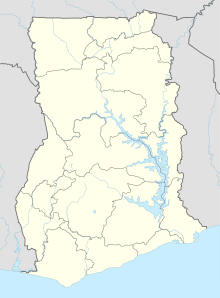Koforidua
Coordinates: 6 ° 6 ′ N , 0 ° 16 ′ W
Koforidua is a city in Ghana, West Africa , with a population of around 120,971 in the 2010 census. In 1984 there were 58,731. Some sources also refer to Koforidua as New Juaben.
Koforidua is the capital of the Eastern Region and is located about 80 km north of the capital Accra on the main route from Accra to the north. Koforidua lies at the foot of Mountain Obuotabiri in a valley surrounded by the Juaben Mountains.
history
Koforidua was founded in 1834 as the capital of the newly founded Ashanti enclave known as "New Juaben". The founders were refugees from Juaben, which had openly rebelled against the Kingdom of Asante in 1832/34 and declared its independence. An Ashanti army then occupied the region after weak resistance, which caused a considerable part of the population to leave the country in view of the threat of reprisals by the Ashanti king. They moved in a south-easterly direction, where they found new settlements on the border between the kingdoms of Akim-Abuakwa and Akwamu with the approval of the local rulers. The capital of the new enclave was the newly founded Koforidua.
When, in connection with the destruction of the Ashanti Empire, the dethroning of the Ashanti king and the burning of Kumasi by the British in 1874, numerous provinces that had previously belonged to Asante were split off, Juaben was among them. Juaben openly rebelled against the Ashanti supremacy and, in connection with the defeat of Asante, one saw the chance to permanently withdraw from the influence of the now pro-British Ashanti king. Without further ado, independence from the Ashanti confederation was declared. Together with also breakaway regions such as Salaga, Atebubu, Yeji, Buëm, Kratschie and some groups from Nsuta and Kwahu, the so-called "Northeast Alliance", the forerunner of the Brong Confederation , was formed in 1875 . In the course of the rebellion, Ashantine officials, but also ordinary traders and craftsmen, whose origins pointed to Kumasi or the home country of Asante, were murdered. In order to put down the rebellion, an Ashanti army then marched into Juaben on September 12, 1875. Victory was won quickly and the local rebel leaders were driven into exile. The Dwabenhene himself had been captured and taken to Kumasi . Numerous residents of Juabin left the country in a south-easterly direction in the course of the events and moved to live with their compatriots and relatives in "Neu-Juaben", which was once founded in 1832 as an Ashanti enclave.
Population development
The following overview shows the population by area since the 1970 census.
| year | Residents |
|---|---|
| 1970 | 46,235 |
| 1984 | 58,731 |
| 2000 | 87,315 |
| 2010 | 120,971 |
economy
The important thing in the area around Koforidua is the cultivation of cocoa , from which the people live to a large extent. The cultivation of wheat , manioc (cassava) and the production of palm oil are just as important . In addition, Koforidua is an important center of forestry.
religion
Since 1992, Koforidua has been the capital of a Roman Catholic diocese that consists of 92 churches, 118 chapels and 11 parishes. The institutions are looked after by 30 diocesan priests, 20 missionaries and over 600 catechists. The diocese looks after a total of 15 hospitals.
sons and daughters of the town
- Hackman Owusu-Agyeman (* 1941), Ghanaian politician
- Amma Darko (* 1956), Ghanaian writer
- Gershon Koffie (* 1991), Ghanaian soccer player
swell
- ^ The Columbia Electronic Encyclopedia, 6th ed. Copyright © 2006, Columbia University Press
- ↑ Year according to Gruner. Tordoff (William Tordoff: The Ashanti Confederacy , In: Journal of African History , 3, 3, 1962, pp. 399-417) names 1832 as the year of foundation.
- ↑ Juaben, also Juabin, Dwabin, Dwaben or a similar spelling, in Ashanti
- ↑ H. Gruner: Study trip to the Gold Coast to explore the cocoa and cola folk culture , In: Der Tropenpflanzer , 8 (8), 1904, pp. 418–431; 8 (9), 1904, pp. 492-508 and 4 (10), 1904, pp. 540-559
- ↑ "Dwabenhene" is the title of the King of Juaben.
- ↑ DJE Maier: The Dente Oracle, the Bron Confederation, and Asante: Religion and the Politics of Secession , In: Journal of African History , 22 (2), 1981, pp 229-243
- ^ Theophil Opoku: Eine Neger-Pastor's Preaching Trip through the Countries on the Volta River , In: Evangelisches Missions-Magazin (Basel), NF, 29 (July), 1885, pp. 257ff., 305ff., 353ff.
- ↑ Ghana: Regions & Cities - Population Statistics, Maps, Charts, Weather and Web Information. Retrieved January 6, 2019 .
